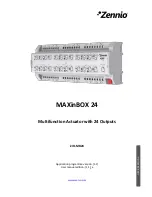
Theory of Operation
2-7
the branch cables for instrument-to-system communication via the ACC,
and also over the local distribution cable(s) for instrument-to-instrument
communication when the local distribution network (LDN) exists.
Only one instrument broadcasts patient data at a time and the ACC
rebroadcasts that information from that branch to all other branches on
the system. The ACC functions as a rotary switch successively allowing
each branch to transmit data to all other branches. The communication
system is designed so every instrument gets a chance to transmit all its
available data within predetermined cycles. The functional operation and
timing sequence of the SDN communication cycle is described below.
SDN Timing Overview
Most information is broadcast by the SDN instruments once every system
cycle, or approximately once every second, such as bed labels, derived
parameters and time-of- day. Other system information, such as
physiological waveform data, is broadcast once every poll cycle or 32
times a second. The ACC controls data communication on the SDN in
blocks of time called system cycles. One system cycle lasts 1.024 seconds
and is made up of 32 separate poll cycles.
Poll Cycle
: One poll cycle lasts 32 milliseconds. Each poll cycle is made up
of three distinct segments, which are:
Sync Tap.
The sync tap acts as a system synchronization strobe. It is sent
by the ACC to all branches (instruments) simultaneously to synchronize
the instrument’s transceivers and to initiate the beginning of a new poll
cycle. The sync tap also contains coded status information.
4 Ms Dead Time.
The 4 ms dead time is an enforced quiet time that
immediately follows the sync tap.
During the 4 ms dead time each instrument reads data stored by the SDN
interface circuitry during the previous poll cycle and stores data to be sent
during this poll cycle. This is the only time SDN data can be loaded into
and retrieved from the instrument’s SDN interface circuitry.
Talk Time.
During the talk time a talk tap message is sent to one branch at
a time starting with branch 0 to grant permission to talk on the SDN.
When a talk tap has been received, the instrument on that branch
transmits all of the data stored in its transmit memory. When finished, the
ACC senses silence on the branch and sends a talk tap to the next branch.
The amount of data transmitted during the talk time varies from branch to
branch and changes from poll cycle to poll cycle, so talk taps do not occur
in the same place every cycle. After all branches have been polled once, no
more data is transferred until the next poll cycle.
SYNC TAP
4 MS DEAD TIME
TALK TIME
Содержание 78581B
Страница 46: ...ACC Maintenance 4 2 ...
Страница 54: ...Installation Responsibilities Customer and Agilent Technologies 6 4 ...
Страница 90: ...Procedures 8 28 ...
Страница 98: ...Contacts 10 6 ...
















































